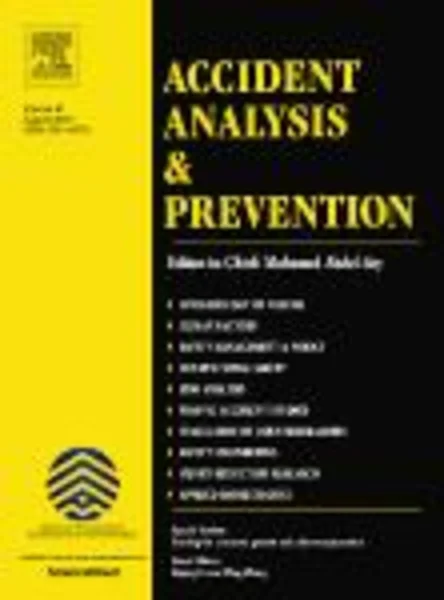-
the influence of conformity and group identity on drink walking intentions: comparing intentions to drink walk across risky pedestrian crossing scenarios
جزئیات بیشتر مقاله- تاریخ ارائه: 1392/01/01
- تاریخ انتشار در تی پی بین: 1392/01/01
- تعداد بازدید: 640
- تعداد پرسش و پاسخ ها: 0
- شماره تماس دبیرخانه رویداد: -
despite the dangers associated with drink walking, limited research is currently available regarding the factors which influence individuals to engage in this risky behaviour. this study examined the influence of psychosocial factors upon individuals’ intentions to drink walk across four experimental scenarios (and a control condition). specifically, a 2 × 2 repeated measures design was utilised in which all of the scenarios incorporated a risky pedestrian crossing situation (i.e., a pedestrian crossing against a red man signal) but differed according to the level of group identity (i.e., low/strangers and high/friends) and conformity (low and high). individuals were assessed for their intentions to drink walk within each of these different scenarios. undergraduate students (n = 151), aged 17–30 years, completed a questionnaire. overall, most of the study's hypotheses were supported with individuals reporting the highest intentions to drink walk when in the presence of friends (i.e., high group identity) and their friends were said to be also crossing against the red man signal (i.e., high conformity). the findings may have significant implications for the design of countermeasures to reduce drink walking. for instance, the current findings would suggest that potentially effective strategies may be to promote resilience to peer influence as well as highlight the negative consequences associated with following the behaviour of other intoxicated pedestrians who are crossing against a red signal.
مقالات جدیدترین رویدادها
-
استفاده از تحلیل اهمیت-عملکرد در ارائه الگوی مدیریت خلاقیت سازمانی و ارائه راهکار جهت بهبود
-
بررسی تاثیر ارزش وجوه نقد مازاد بر ساختار سرمایه شرکت های پذیرفته شده در بورس اوراق بهادار تهران
-
بررسی تأثیر سطح افشای ریسک بر قرارداد بدهی شرکت های پذیرفته شده در بورس اوراق بهادار تهران
-
بررسی تأثیر رتبه بندی اعتباری مبتنی بر مدل امتیاز بازار نوظهور بر نقد شوندگی سهام با تأکید بر خصوصی سازی شرکت ها
-
تأثیر آمیخته بازاریابی پوشاک ایرانی بر تصویر ذهنی مشتری پوشاک ایرانی (هاکوپیان)
-
مفاهیم فطرت انسان درتمدن غرب
-
روش هیبریدی ماشین های بردار پشتیبان و جستجوگر هارمونی در پیش بینی عملکرد بهینه مخازن
-
بازار نیروی کار صنعت زعفران و شوک های اقتصادی
-
بررسی تطبیقی شباهت ها و تفاوت های اجرای اسناد در اداره ثبت و اجرای احکام در دیوان عدالت اداری
-
green route for the chlorination of nitrobenzene
مقالات جدیدترین ژورنال ها
-
مدیریت و بررسی افسردگی دانش آموزان دختر مقطع متوسطه دوم در دروان کرونا در شهرستان دزفول
-
مدیریت و بررسی خرد سیاسی در اندیشه ی فردوسی در ادب ایران
-
واکاوی و مدیریت توصیفی قلمدان(جاکلیدی)ضریح در موزه آستان قدس رضوی
-
بررسی تاثیر خلاقیت، دانش و انگیزه کارکنان بر پیشنهادات نوآورانه کارکنان ( مورد مطالعه: هتل های 3 و 4 ستاره استان کرمان)
-
بررسی تاثیر کیفیت سیستم های اطلاعاتی بر تصمیم گیری موفق در شرکتهای تولیدی استان اصفهان (مورد مطالعه: مدیران شرکتهای تولیدی استان اصفهان)
-
رابطه ی مولفه های معنویت گرایی با زندگی ارزش محور در زنان مبتلا به روماتیسم مفصلی
-
بررسی میزان و شدت عشق آنلاین در کاربران اینترنتی
-
تأثیر آموزش منابع انسانی بر رفتار شهروندی (مورد مطالعه کارکنان علوم پزشکی شهرکرد)
-
تبیین رابطه فضیلت سازمانی و کیفیت زندگی کاری با اشتیاق شغلی معلمان (مورد مطالعه: معلمان مدارس ابتدایی شهر کامیاران)
-
رابطه ی باورهای دینی و سبک های مقابله ای با هوش هیجانی در دانش آموزان مقطع متوسطه ی دوم شهر شوش در سال 1395




سوال خود را در مورد این مقاله مطرح نمایید :